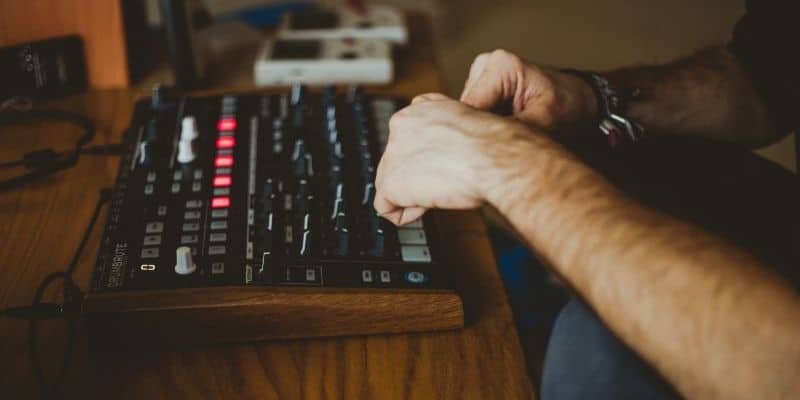Skip to the good bit
ToggleFirstly, we judge sound quality subjectively, based on music taste and preferences. Some people may prefer bass-heavy tunes, whereas others might prefer a more lively v-shaped experience. Secondly, the sound quality (or accuracy) is determined by the frequency range.
To better understand audio quality, this guide will uncover everything to do with frequency, including how it affects your headphones.
What Is Sound Frequency?
Sound is created by vibrations in the air. As a sound wave reaches your ear, the membranes in your ear vibrate, allowing you to hear the sound in all its glory. But, of course, there’s a lot more science to it than that.
Sound waves consist of five characteristics:
- Wavelength
- Time period
- Amplitude
- Frequency
- Speed
The frequency part of a sound wave is incredibly important – it relates to how fast the waves are moving and determines the pitch. The higher the frequency waves oscillate, the higher the pitch of the sound. This is where treble and bass come into play.
Treble
The faster, smaller vibrations in the frequency range are called ‘treble’. Treble tones are at the higher end of human hearing and tend to sound more ‘bright’. In technical terms, treble corresponds with any frequency higher than 6kHz (6000 oscillations per second).
When it comes to controlling the treble on your headphones, turning it up will make your music sound more detailed and lively. Turning it down will make your music sound more mellow.
Bass
As you may have guessed, the bass is the opposite of treble. Bass tones are at a lower frequency, corresponding with anything up to 256Hz (256 oscillations per second). The ‘boom’ you can hear or the ‘rumble’ your body feels is the bass getting to work.
If you turn the bass up on your headphones, the sensitivity will increase. This essentially means that your music may sound louder and make bass instruments more apparent.
It’s important to remember that the bass is what travels through floors and walls, so consider turning it down if you don’t want to disturb neighbours or household members.
Middle
When you adjust the treble and bass, you naturally tweak the middle band that sits in between the two (from 200Hz to 5kHz). Mid frequencies are particularly helpful when listening to voices. Turning down the treble and bass will boost mid frequencies, making voices easier to hear.
Due to being harder to identify, most standard headphones won’t have a mid-band frequency control. If it’s important to you, however, investing in a pair of top-notch headphones may help.
Is Frequency Range Important For Sound Quality?

It’s all well and good knowing how sound frequencies work, but when it comes to headphones, how important are they? Once again, the answer is a subjective one, but the same basic rules apply.
The majority of headphones are designed to match the human hearing bandwidth (20Hz to 20kHz). Due to this, you won’t have to worry about tweaking the frequency range unless you have very specific music tastes. The majority of us can pick out low, middle and high frequencies, and there’s no need for any changes.
With that being said, if you prefer songs to sound brighter, increasing the treble frequency will improve your audio. The same applies with the bass; increase it if you want more of an impact.
FAQs: Treble vs Bass

So – you now know that treble and bass affect the pitch of your music. But, there’s a lot more to them than just turning them up and down. Producers have to understand how they work together in order to get the highest quality of audio possible.
To better understand how treble and bass affects your headphone quality, we’ve cracked down on some frequently asked questions.
Does Treble Affect Bass?
Although on complete opposite ends of the pitch spectrum, treble and bass affect each other. Treble lowers the vibration in your headphone’s subwoofers in order to maintain balance throughout the whole song. This is important, as most listeners cannot withstand full-on bass without becoming fatigued. However, if you have one without the other, the music may sound distorted and hinder in quality.
Should Treble Be Higher Than Bass?
To get the best quality of audio possible, treble should always be higher than bass. This is for three main reasons:
– To reduce any stagnancy in mid-frequencies
– To make vocals clearer
– To balance any low rumbles
Keeping the treble higher than the bass creates an ‘equaliser’, which is important for maintaining top-quality sound throughout the whole track. The rules here will vary depending on the style of music, but as a general rule of thumb, treble should always be higher than bass.
What Level Should I Set My Treble And Bass At?
If you do find yourself playing around with frequency levels, we recommend following the 4:5 ratio. The 4:5 ratio allows the treble to sit on the pedestal while the bass takes the backseat (this might sound like we’re favouring treble, but letting bass sit in the shadows is exactly what most songs need to shine).
What’s Better – Treble Or Bass?
It’s a stone-hard fact that neither treble nor base is better! Listening to either of the two in dominance for too long can damage your hearing, which is why most headphones keep human hearing levels in mind. A balance (equaliser) between the two is needed for the best listening experience.
Can Adjusting Treble and Bass Improve Headphone Longevity?
While adjusting treble and bass levels primarily affects audio output quality, it doesn’t directly impact the longevity of your headphones. However, consistently playing music at extremely high volumes, especially with heavy bass, can strain the headphones’ drivers over time. Moderation is key to preserving your headphones’ life while enjoying your preferred sound settings.
How Do Treble and Bass Settings Affect Battery Life in Wireless Headphones?
Various factors, including volume level and active noise-cancelling features, can influence the battery life of wireless headphones. Adjusting treble and bass settings in themselves does not significantly affect battery life. It’s the overall volume that plays a more critical role; higher volumes can lead to quicker battery depletion. Therefore, enjoying your music at moderate volume levels is advisable for longer listening sessions.
Is There a Universal Setting for Treble and Bass That Works for All Genres?
There is no one-size-fits-all setting for treble and bass that suits all music genres. Each genre has its unique characteristics and sound profiles. For example, classical music may benefit from a more balanced or even slightly treble-focused setting to highlight its intricate high notes, while hip-hop or electronic music might shine with a bit more bass. Personal preference plays a significant role, and experimenting with settings to find what best suits your taste for different genres is recommended.
Treble And Bass Are Friends, Not Enemies
There’s a common misconception that you can’t love treble if you love bass; vice versa. However, we hope this guide has provided some insight on why that isn’t the case. Although enjoy them in safe moderation, they will have their time to shine depending on the listeners, but songs sound better when they work together.









